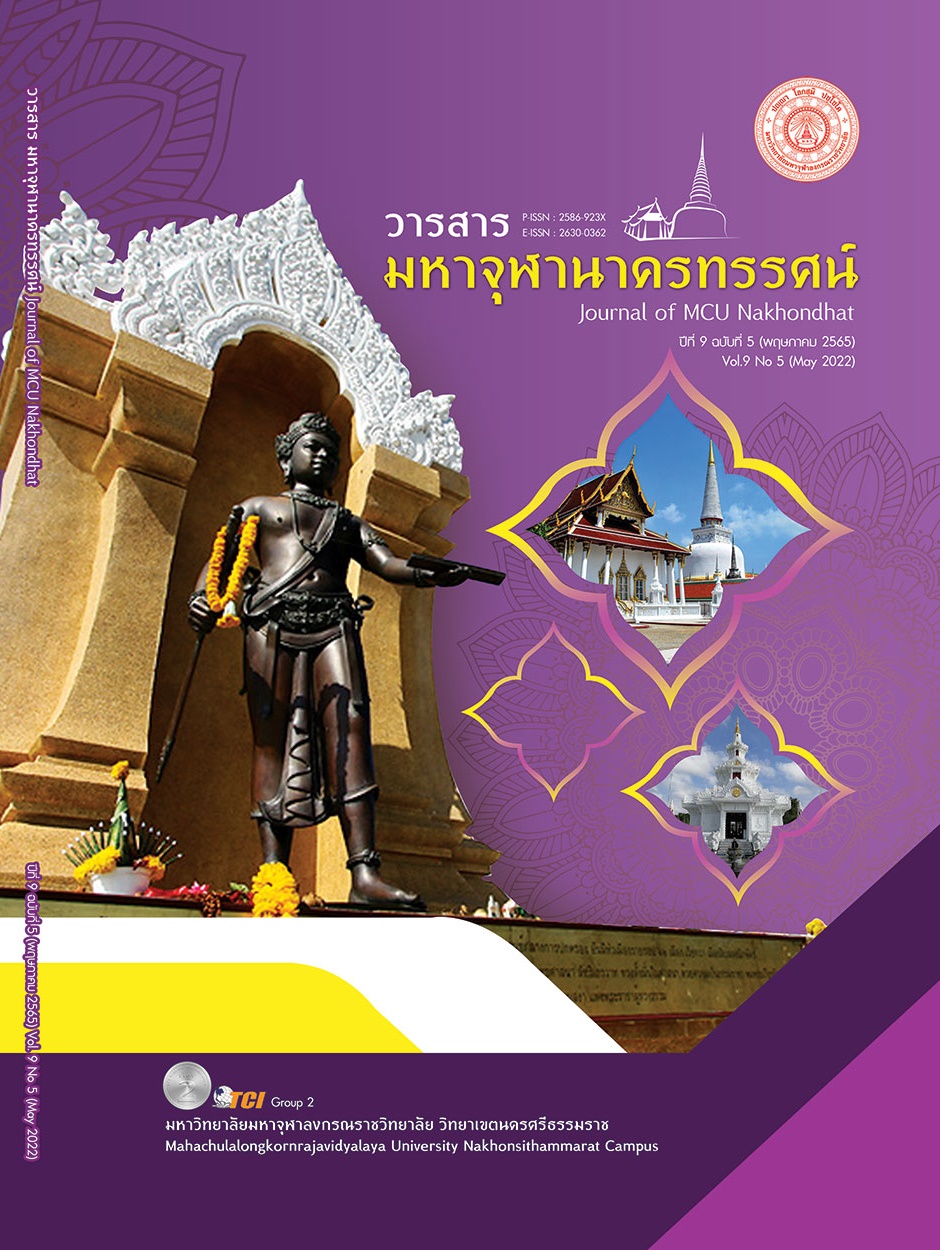COMPETENCY DEVELOPMENT IN ART LEARNING MANAGEMENT OF SCHOOL ART EDUCATION TEACHERS THAT DEVELOPS THE 21st CENTURY LEARNER SKILLS THROUGH ONLINE TRAINING
Main Article Content
Abstract
This R&D methodology research aimed to 1) Develop competence in art learning management that develops 21st-century student skills for school art teachers with online training and 2) study the effectiveness of competency development online training in art learning management for 21st-century learner skills. The research was conducted with a specific sample group, i.e. 26 art education student teachers who 've practiced teaching in schools. For the academic year 2021, were researched. The research tools consisted of 1) a knowledge test in art learning management that improves learner skills in the 21st century., 2) a quality assessment teaching plan form., 3) a report teaching form., and 4) a satisfaction questionnaire for the curriculum. The results showed that 1. Competency Development in art learning management that develops learner skills in the 21st century by developing the “The enhancing competence online curriculum training in art learning management to develops 21st-century learner skills.” consist of principles, objectives, content, The learning management designing plan process, learning evaluation, and the media that use the website developed by the researcher as a learning resource. 2. The effectiveness of online training courses in developing art learning management competency. Able to develop competency in art learning management of teachers in schools that develop learner skills in the 21st century, consisting of 1) knowledge, 2) the ability to design art lesson plans, 3) adopting a developed art lesson plan up to students by integrated of technology in teaching arts in various forms; 4) awareness of teaching art to develop the 21st-century learner skills. Additionally, the teachers who attended the training had a high level of satisfaction (4.32) in participating in the online training activities according to the curriculum.
Article Details

This work is licensed under a Creative Commons Attribution-NonCommercial-NoDerivatives 4.0 International License.
References
คณะกรรมการอิสระเพื่อการปฏิรูปการศึกษา (กอปศ.). (2562). รายงานพันธกิจด้านการปฏิรูปการศึกษา. เรียกใช้เมื่อ 10 พฤศจิกายน 2563 จาก : http://backoffice.onec .go.th/uploads/Book/1734-file.pdf
ณชนก หล่อสมบูรณ์ และอภิชาติ พลประเสริฐ. (2563). ศิลปะเพื่อจูงใจการเรียนรู้ของเด็ก. วารสารศิลปกรรมศาสตร์ มหาวิทยาลัยศรีนครินทรวิโรฒ. 24 (1), 97-108.
ณัฐธิดา ภู่จีบ, ปุณณรัตน์ พิชญไพบูลย์และเอกชัย กี่สุขพันธ์. (2563). รูปแบบการพัฒนาสมรรถนะการสอนสำหรับครูทัศนศิลป์ในโรงเรียนระดับมัธยมศึกษา. วารสารครุศาสตร์จุฬาลงกรณ์มหาวิทยาลัย. 48(3), 106-124.
พิชญาภา ยืนยาว, วรรณี สุจจิตร์จูล, ธีรวุธ ธาดาตันติโชค, ณัฐวรรณ พุ่มดียิ่ง, และพนมจอง เฉลิมชัย. (2563). การพัฒนารูปแบบกลไกและระบบการคัดกรองผู้ประกอบวิชาชีพครูตามมาตรฐานวิชาชีพของคุรุสภา. คุรุสภา วิทยาจารย์, 1(2), 11-26.
พีระพงษ์ กุลพิศาล, (2561). พลังสร้างสรรค์กับการศึกษาศิลปะ. วารสารสารสนเทศ, 17(1), 49-58.
ภานุมาศ หมอสินธ์, ณัฐวัชต์ บุญภาพ, สมาน กาบมาลา, สาธิต วงค์จันทร์ และณภัทร วิหคน้อย. (2563). การอบรมออนไลน์เพื่อพัฒนาทรัพยากรมนุษย์. วารสารวิชาการสถาบันวิทยาการจัดการแห่งแปซิฟิค(สาขามนุษยศาตร์และสังคมศาสตร์). 6(3), 347-357.
สมเกียรติ อินทสิงห์. (2562). การพัฒนาหลักสูตรการคิดสำหรับการเรียนรู้ในศตวรรษที่ 21 ในหมวดวิชาศึกษาทั่วไปที่เน้นการเรียนรู้เชิงรุกสำหรับนักศึกษาปริญญาตรี มหาวิทยาลัยเชียงใหม่. วารสารศึกษาศาสตร์ มหาวิทยาลัยขอนแก่น, 42(3), 37-52.
สำนักงานเลขาธิการสภาการศึกษา. (2562). รายงานการศึกษา แนวปฏิบัติของการสร้างและส่งเสริมการรู้ดิจิทัลสำหรับครู. เรียกใช้เมื่อ11 ธันวาคม 2562 จาก : http://online.fliphtml5.com/wbpvz/ivpc/#p=14 ()
สำนักงานคณะกรรมการพัฒนาการเศรษฐกิจและสังคมแห่งชาติ. (2561). “ยุทธศาสตร์ชาติ ระยะ 20 ปี พ.ศ. 2561 - 2580”. เรียกใช้เมื่อ 1 พฤศจิกายน 2563 จากhttps://www.nesdc.go.th/download/document/SAC/NS_SumPlanOct2018.pdf
สืบศักดิ์ สิริมงคลกาล. (2563). ศิลปศึกษาท่ามกลางกระแสรูปแบบการเรียนการสอนในศตวรรษที่ 21. วารสารวิชาการ คณะมนุษยศาสตร์และสังคมศาสตร์ มหาวิทยาลัยราชภัฏนครราชสีมา, 2(2), 69-81.
สุภิญญา สมทา, พรเทพ เลิศเทวศิริ, และอินทิรา พรมพันธุ์. (2564). การสอนศิลปศึกษาเพื่อส่งเสริมทักษะการเรียนรู้ และทักษะชีวิตในโรงเรียนประเทศไทย. วารสารศึกษาศาสตร์ปริทัศน์, 36(2).
ไสว ฟักขาว และ อาภาพร สิงหราช (2563). ครูนักออกแบบการจัดการเรียนรู้ในศตวรรษที่ 21. วารสารปัญญาภิวัฒน์, 12(2), 302-315.
Dempsey, C., Harris, J., & Hofer, M. (2013). Grounded technology integration: Visual arts. Learning & Leading with Technology, 40(5), 36-38.
Dick, W., Carey, L., & Carey, J. O. (2001). The Systematic Design of Instruction. New York : HarperCollins.
Duke, L. L. (1990). Mind building and arts education. Design for arts in education. 91(3), 42-45.
Ecoma, V. E. (2018). Ways of Knowing In The Visual Arts: The Imperative of Sense Perception And The Creative Process. Journal of the Arts/Humanities, 1(2). 13-25.
Hogan, J., Jaquith, D., & Gould, L. (2020). Shifting perceptions of quality in art education. Art Education, 73(4), 8-13.
Ilić, V., Stojanović-Đorđević, T., & Šikl Erski, A. (2018). ICT and art education. In 7th International Scientific Conference Technics and Informatics in Education: Faculty of Technical Sciences, Čačak, Serbia, 25-27th May 2018 (pp. 32-38).
Maras, K. (2019). Reconciling critical and creative thinking capabilities and critical practice in visual arts education: A work in progress. Australian Art Education, 40(2), 262-276.
Rodríguez Moreno, J., Agreda Montoro, M., & Ortiz Colón, A. M. (2019). Changes in teacher training within the TPACK model framework: A systematic review. Sustainability, 11(7), 1870.


